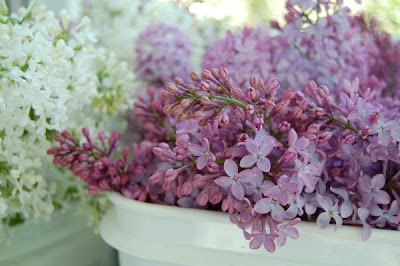. . . ten years ago at a quiet courthouse ceremony in San Francisco. For their anniversary, they decided to throw a party complete with family, friends, food, and flowers. The Monkey Flower Group provided the last of these.
My favorite way to decide what materials to use in my designs is to see what nature offers up and go from there. This way the flowers are truly representative of the beauty of the day, rather than just an arbitrary or contrived decoration. R&J agreed to using exclusively local materials (amazingly, considering they are farmers and know what havoc spring weather can wreck on plants), and nature rewarded us with buckets and buckets of early lilac (above).
To decorate the venue's entrance, I rigged up these hanging vases of wild grape vine and canning jars using a power drill and an adaptation of the technique described in my May Day basket project. Here they are before installation empty (above left) and full (above right). The resulting swags looked a little like old grapevines loaded with lilac grape bunches (below).
Now for me, the "problem" with lilac is that whenever I have access to it, it is all I want to use. I indulged in single variety romantic abundance for the entrance decorations, but for the remainder of the arrangements I wanted something a little more mature and modern feeling. Bold groupings of chocolate mint and deep purple mystery foliage from my garden provided depth and interest without making things too flowery (below).
For their guests, R&J requested small, simple boutonnieres. I designed them using an assortment of different textures (below).
R&J's more elaborate boutonniere and hair ornament incorporated all the textures together (below).
And for the kids, there were botanical wands and masks (below).
Happy anniversary, R&J!
May 10, 2010
Subscribe to:
Post Comments (Atom)



















Oh my goodness, everything is amazing!!! I love the hanging lilac and the way you made all the guest boutonnieres and hair ornaments from the different elements of the bride and groom's like the parts of two families and their friends coming together to honor the special couple (and that you made hair ornaments and not corsages) and wands and masks for the kids too! Wonderful!
ReplyDeleteYou are ridiculously talented - thank you for your inspirational blog!How do you stop the boutonnieres drying out and wilting?
ReplyDeleteThanks guys!
ReplyDeleteBelinda, I am looking forward to seeing how your cutting garden adventure goes! What is a black barn?
As for keeping the boutonnieres fresh, it starts with using hardy materials. I'm constantly experimenting with leaves, seeds, tendrils, grasses, flowers, and buds to see what will hold up out of water. The maple whirligigs, grasses, vinca, crocus leaves, arbor vitae, and iris leaves I used for R&J's celebration all passed the two day test. Beyond that, just mist with water and keep in a cool, dark place away from other flowers or fruits which might release ethylene gas and speed up the senescence process.
Happy harvesting!
Thanks so much for the info. Our home is a clapperboard black barn - originally a 18th century granary used for storing the grain harvest. It is part of an old farmstead - the main farmhouse, coach-house, forge and two barns. The farm wasn't viable anymore, and they were made into 5 separate houses, but all restored really sympathetically. There is also the remains of the old flour mill, now a walled rose garden belonging to our neighbour.
ReplyDeleteThere are quite a lot of them in the south of England, up north they tend to be made of stone. I'll put a picture on my blog one day.
There is a small river running through the plot, so quite a bit of foraging potential - I love the way you describe using wild material aswell as cultivated. You have an artist's eye, your arrangements are like paintings,really different to a standard florist, and very inspiring.
My teenyweeny cut flower business has just grown out of friends wanting similar flowers to the ones I grow for the house. I have no gizmos and gadgets - no florists refridgeration or polytunnels. Do you condition flowers without a florists refridgerator? Belinda
Belinda, your home sounds amazingly beautiful and idyllic! What an appropriate use for an old farm; I love to hear about old buildings finding new lives. I can't wait to see photos.
ReplyDeleteLike you, I don't have a any gizmos or gadgets, just really clean containers/water, a really sharp knife, and a relatively cool dark spare room for flower conditioning and storage. When I relocate to California next month I plan to obtain a small cooler. Low temperatures really do wonders for vase life!
If you haven't already come across it, you might try looking up Allan Armitage's book Specialty Cut Flowers. The growing information is tailored for American climates, but I'm sure you'd still find lots of relevant tips. And the harvest stage and conditioning instructions should apply everywhere I'd think.
Best of luck! I'm looking forward to hearing about/seeing your flowers (and business) grow!
Looked up the book, and just bought a secondhand copy from Amazon! Custard tarts in the oven and off to the garden to get blooms for a bouquet for a neighbour - ye gods, i'm turning into Martha Stewart, better get my nose pierced or something! Thanks for the tips.
ReplyDeleteBelinda thanks for the great discussion! And Jaime, I love lilac so much, these arrangements are beyond amazing.
ReplyDeleteYay! I'm glad you found a copy of that book. I hope it is as useful to you as it has been to me. And as for turning into Martha . . . I think your neighbor won't mind!
ReplyDeleteLiz, I had a feeling you might like those bouquets and am happy you do. I think you brought me a lilac posy at Vintage High, and I think it was the first time I ever encountered lilac in the flesh. Whoa, right?